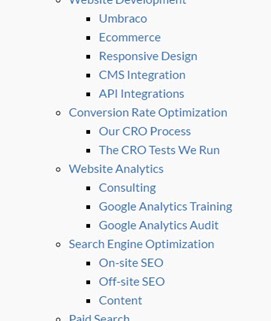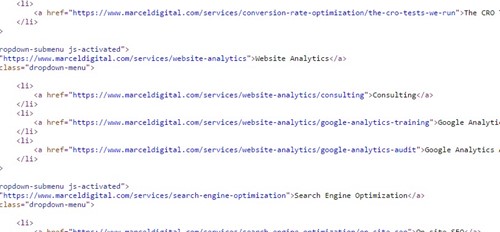
Developing a website is an exciting time in your business’s history, but it can also be a stressful time if the proper steps are not taking to ensure a quality product is being created. Designing and building a website takes time, responsibility, and regular check-ins from multiple team members working on different task items, so it’s important that all parties have a centralized structure that can easily be referred to during this time. It also means that teams should be meeting regularly so that responsibilities and deadlines are being accounted for.
Below, we walk through a basic, high level web development process and how it can help your team get on the same page during your website’s development or redevelopment. Let’s begin...
Defining Your Website's Goals
First, it’s important you clearly define what the website’s goal and purpose is. Without this fundamental piece, the rest of the process is flawed, because if you go into a creating a website without a clear goal, you could waste a lot time and resources in the process, ultimately frustrating your target audience and leaving money on the table.
It’s best that you meet with your team to discuss and ask yourselves the following questions:
- What is our business trying to accomplish?
- What is our business’s value to the community and user?
- What are our most important products or services?
- What does our audience need to know most?
- What does our audience know most?
- How can we better showcase these answers to these questions (and more)?
Some examples of website goals include:
- Prioritize business and product information
- Increasing brand awareness and visibility
- Create more sales opportunities
- Increase customer satisfaction
- Showcase events & company
- Etc.
A website is a living and breathing aspect of your business. Setting solid goals and a direction that your team, as a whole, can strive for will ensure that your brand’s story is told in a solid and consistent fashion that aligns your business goals with your audience’s goals. This stage will be especially important for mapping your Google Analytics implementation as well, so you can properly measure engagement and goal metrics to see if your site is working to achieve what it needs to!
Structuring And Organizing Your Website

Not only is organizing your website in a logical structure important from a user experience and navigation standpoint, but it’s also important from a search engine optimization standpoint. Search engines want a website that’s easy to crawl and index so that they can return results for user’s queries that provide an exceptional user experience.
So, that being said, while organic visibility is extremely important, the most important reason for structuring your website in a logical fashion is for your users. They want to be able to easily find what they are looking for and move through your website fluidly. Roadblocks or obstacles like hard to find pages or overloaded navigation bars will quickly discourage your users from engaging your website any longer, causing them to potential leave and move on.
When structuring and organizing your website, it’s important that you sit down with your team and create a sitemap. When you create your sitemap, it’s important you think like a user that will be actively engaging your website. Ensure that:
- Important information is easy to find
- Pages aren’t hidden or buried
- Next steps or calls to action are clearly defined
- That users can always contact your team if they are having issues
If you map your website out in a logical fashion that’s easy to navigate and browse, both users and search engines will appreciate the gesture, one potentially monetarily or with loyalty and the other with visibility.
Designing Your Website
Now that the structure and overall organization of the website is in place, you’ll now want to ensure that the overall look and feel of the website is aligning with your brand and consistent across the board. The website design process is a lot like the web development process, they both take careful planning and execution.
When it comes to web design, you are trying to capture what the brand wants to represent most and what your target audience (based on your research) would like to see most. Different types of websites have unique presentations and functionalities that their users have come to expect. It’s important that your design team provides you with a few variation mockups of a website, that way, you can see how your website would look and feel in different layouts and designs, and choose the one that you feel is best overall.
It’s extremely important that your design team sends progress reports so that changes can be made and so that web developers can let them know the limitations and potential functionality pitfalls of their designs. This will also ensure a more fruitful collaboration amongst your teams, as it will speed future web design and development projects up in the future.
Coding And Development
After a design and layout has been decided upon, it’s time to make it all come to life! Your web developers should meet with your designers to get the finalized mockups off of which they will build the site from. Generally, the web development team will create templates of interior pages where content loaders can then upload new content to the website to see how it would look and function.

It’s important to note here that when it comes to content loading, you should pick an easy to use CMS that marketers and non developer employees can use to make quick changes to the website without bugging the web development team. That being said, you also will want your developers to be happy with your choice in a CMS and will definitely want their input from a development standpoint. As Certified Gold Partners, we highly recommend our partners at Umbraco as a CMS solution for you and your team when developing your website. You can learn more about our services here!
It’s important your new website is being developed on a test site, so that it can be tested and browsed like a live production website would be. This is important because you can then have members of your team regularly browse the website and notify developers of issues that they have. This will give you more chances to find.
Testing And Debugging Issues
The final step of the web development process is to make sure you are testing your website before you launch it. The reason being, sometimes issues and problems can sneak by your developers and if you launch your website with problems on your site, it can lose you customers and give the impression your business is careless. Make sure you test your site before you launch by asking yourself good question as you browse:
- Does all functionality work as it should?
- Do pages properly populate?
- Are there broken images or links?
- Is all content properly loaded and in the right spot?
- Are all SEO best practices being followed?
- Are pages loading slowly?
- Does the site utilize responsive design properly?
While this list is a great place to start, it doesn’t cover all of the questions you should ask, and could potentially open up the doors to many more questions. Feel free to create your own list and pass along to your testing team to get their minds jogging when they are browsing the test website. Create a shared document in Google or internally so all feedback is in one place and can be referenced as testing continues.
Conclusion
Remember, this is just a high level process to get you and your team discussing, and is by no means all encompassing of the intricacies of web development. The beauty of this process is that it can be tailored and customized to your unique resources and circumstances, it’s merely meant to be a direction for you and your team to head. It's important to note that just because your website launched, doesn't mean the party is over! Make sure you have a team in place to handle potential issues with the website and how they can be remedied when they occur. Web development is a very exciting time, it allows you to showcase your brand and services in a new exciting way, but it has to be done with a level head and a clear direction. If it’s not, your new website could become a new headache, for both you and your customers. Start off on the right foot with a solid plan!
If you’re looking to develop or redevelop your website, take a look at the website development services from Marcel Digital. Not only are we an Umbraco Gold Partner, but we’ve developed hundreds of websites for industries ranging from healthcare to eCommerce. Feel free to contact us if you have any questions - our team of web development experts are happy to help in any way that they can!
SEO
About the author
Joe Stoffel
Joe knows what it takes to drive SEO results. He is an experienced SEO specialist who currently leads the SEO department and strategy at Marcel Digital.